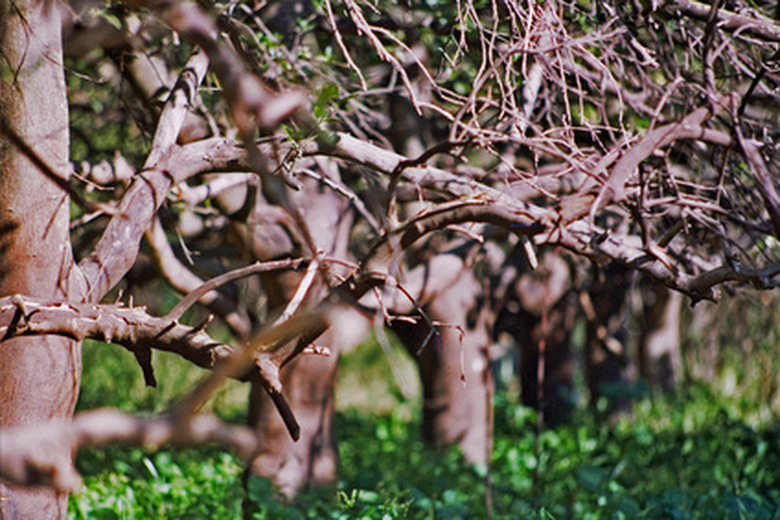List Of Zone 6 Fruit Trees
Home gardeners often dream of an orchard in the back yard; how nice to walk outside and pick a few apples or cherries of your own. But USDA Zone 6 gardeners may mistakenly think the hot, humid summers aren't suitable for fruit tree growing. Don't cheat yourself out of an orchard–many varieties grow well in zone 6, including most of the favorite orchard fruits.
Apples
Apples are a suitable fruit tree crop for zone 6 gardeners. Particular varieties that should do well include Grimes, Golden, Rome, Stayman and Winesap. Liberty is another cultivar that is disease-resistant and grows well in the zone 6 climate. According to "The Big Book of Gardening Skills," zone 6 gardeners should avoid the varieties that grow well in colder zones, including Duchess, Quinte and those in the McIntosh family. Missouri Extension advises that two apple trees usually provide a good supply of apples for a family of four.
- Home gardeners often dream of an orchard in the back yard; how nice to walk outside and pick a few apples or cherries of your own.
- According to "The Big Book of Gardening Skills," zone 6 gardeners should avoid the varieties that grow well in colder zones, including Duchess, Quinte and those in the McIntosh family.
Cherries
Cherries, in general, grow well in zone 6. Almost any variety will grow well, even in the warm humid summers. Try Richmond, Bing or Stella for sweet cherries. Montmorency or North Star are suitable varieties for sour cherries to cook into a pie or jams and jellies. On most varieties in zone 6, cherries will ripen for picking in mid-summer.
Peaches
Peaches scream out summer. Warm and juicy fruit is a great reward for all that hard work. Zone 6 gardeners will find that Candor, Elberta, Halehaven, Madison or Redhaven varieties are best suited for their climate. Use peaches picking and eating, for baking into pies and cobblers, and for cooking into jams. They also lend themselves well to freezing (peeled and sliced) for use later in the year.
- Cherries, in general, grow well in zone 6.
- Montmorency or North Star are suitable varieties for sour cherries to cook into a pie or jams and jellies.
Pears
Pears are a late-summer through early-autumn crop for zone 6 gardeners. Try Anjou, Bartlett, Bosc or Clapp Favorite. University of Illinois Extension also recommends Maxine and Moonglow and advises planting pear trees in full sunlight. It's also important to plant pear trees where the ground is well-drained; they will not grow well in wet soil. You'll need at least two pear trees of two different varieties to achieve pollination; pear trees do not self-pollinate.
Plums
Plums are a juicy, sweet choice for home gardeners, who can choose between European or Japanese plums. Stanley and Damson are European plum choices for zone 6; recommended Japanese varieties are Santa Rosa and Premier. Plum trees require regular watering during the growing season; once a week or once every 10 days should do the trick, and when watering you should be sure the ground around the tree is soaked.
- Pears are a late-summer through early-autumn crop for zone 6 gardeners.
- Plums are a juicy, sweet choice for home gardeners, who can choose between European or Japanese plums.
References
- Missouri Extension: Home Fruit Production – Apples
- University of Illinois Extension: Tree Fruits
- Missouri State University Dept. of Horticulture: Growing Fruit
- "The Big Book of Gardening Skills"; Gardenway Editors; 1993
